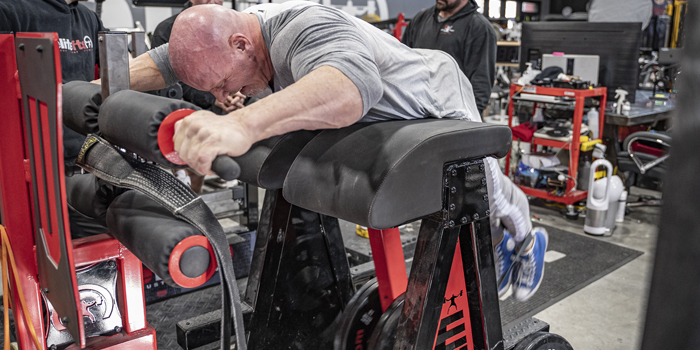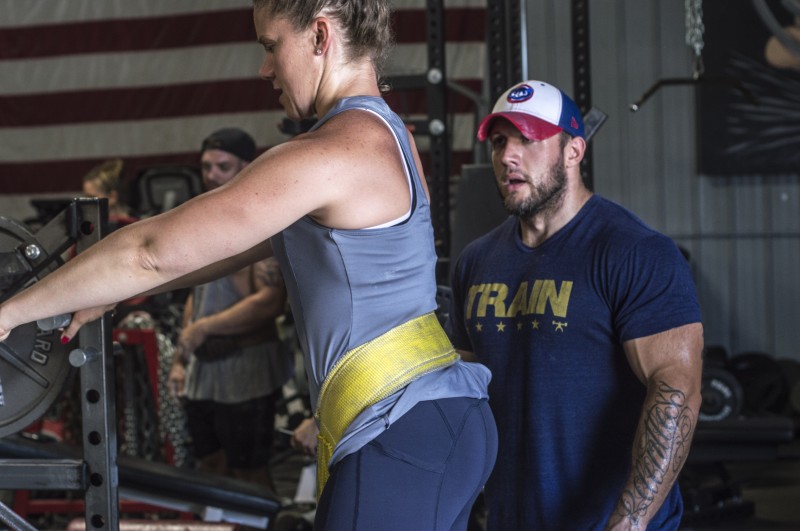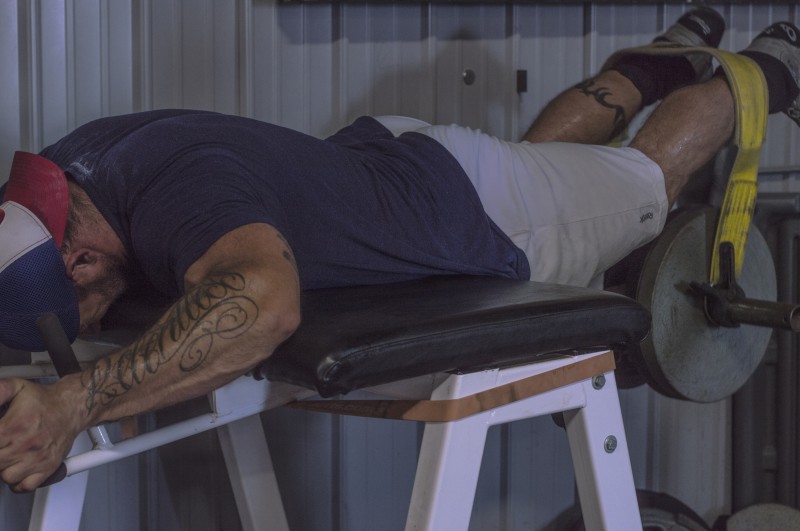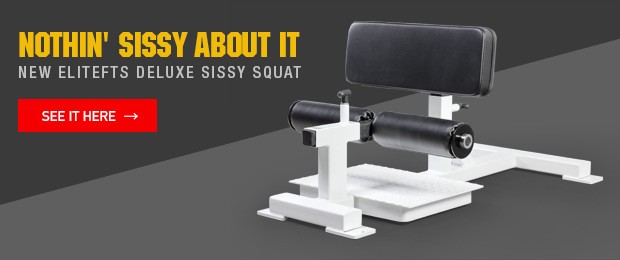
I’ve had my fair share of injuries over the years, but none have had more impact on my life and training than hurting my lower back in 2012. The warning signs were there. Every time I wanted to squat or deadlift, I had to roll my glute out on a cricket ball for a good 20 minutes before starting. The little tweaks and tightness in my hips and lower back were becoming more frequent and beginning to build up over the course of six months.
Then one day, my back had enough. Over the course of the years, I’ve "re-hurt" it more times than I can count, each one being as debilitating as the other. I remember one time blowing it out before going on a date, and being in so much pain that the only way I could sit at the table was by lying on my side. The injury was damage and tearing to the annulars on my L3/L4. While it didn’t require surgery, it did mean countless visits to physios, osteopaths, and chiropractors.
RELATED: Training Through Injury: How To Overcome Disc and Lumbar Issues
One of the big mistakes I made during all of this was not changing my training to accommodate my lower back injuries. Whenever it would feel slightly "better" (anyone who’s had severe back issues knows you’re never quite the same after), I was right back under the bar to squat again. And of course, the cycle repeated itself. Over the last three years, I’ve finally learned from my mistakes, and now train legs in a manner that is back-friendly while still allowing me to train hard. What’s good is that this method of training is actually what suits my body type, and has resulted in more gains in my legs than the traditional squat and deadlift routines I used to follow.
So how can we create the damage and nastiness required for a productive leg workout while sparing our backs?

Paradigm Shift
In previous years, a leg workout may have looked like this:
- Back Squat
- Deadlift
- Lunge or Split Squat
- Leg Curl Variation
Along with a few modifications, the best way to make this immediately more back-friendly is to flip the order and place the compound exercises at the end.
1. Start with Leg Curls
I first learned this from Louie Simmons, who would advocate doing tons of leg curls, glute ham raises, and sled work prior to any heavy lifting. The aim of this is to pump up the hamstrings, fire up the posterior chain, and create more stability around the knees and hips.
Typically I like to do two to three sets of eight to 12 reps.
2. Move to Single-Leg Work
Single-leg work is often overlooked and forgotten. It might be tacked on to the end of a workout with some lunges, but in most cases, it’s never prioritized. If you’ve got lower back pain, using single-leg exercises is a valuable and safe way to load the legs while minimizing stress on the spine. They’ll also help build stability, mobility, and balance in all the typically weak muscles of individuals who suffer from lower back pain (think hip flexors, glutes, and adductors).
The variations are endless, but some of my favorites include:
- Walking Lunges
- Bulgarian Split Squats
- Reverse Lunges
You can load them in a number of ways: goblet, front rack, barbell on your back, or dumbbells. The safest option with the most loading potential is probably dumbbells. While you may be able to get more load with a bar on your back, it may be risky for those who can’t tolerate much compression on the spine.
Two to three sets of eight to 12 reps work well. You could venture into the six to eight rep range on occasion, but I wouldn’t do this too regularly, at the risk of your knee health.
3. Trash Your Quads (Bilaterally)
When training your quads, there are a few ways you can do this. If you’re dead set on squatting still, now would be the time to do it. Everything will be warmed up, and the weight you’ll require to get a training effect will be much less than normal. If you’re used to squatting 100 kilograms for eight reps, this might drop to 80 kilograms. What’s important is you use this "new PR" of 80 kilograms as your benchmark and not your old benchmark of 100 kilograms. This way you check your ego at the door and don’t risk running into further injury.
If you’re going to squat now, I would go for two to three sets of six to 10 reps, making it as difficult for yourself as possible. This means using slower tempos on the way down, and adding pauses at the bottom while maintaining tightness. Free squatting isn’t a bad thing for your body, but if you’re dealing with low back pain, the compressive forces of a heavy bar on your back can cause issues. So any way that you can reduce the load while still trashing your quads is a bonus. Another option is to front squat, where automatically the weight on the bar will be less than during a back squat.
If free squatting is an issue, and you find yourself continuously running into injury again, I’d look at utilizing machines as the primary source of your quad work. This is what I do now, and it works really well in keeping safe. Remember, we’ve got the stability, balance, and mobility benefits of single-leg work, so this should be all about muscle annihilation.
Some of my favorite options here include:
- Hack Squat
- Leg Press
- V-Squat or Machine Squat
If you choose one of these options, keep the reps controlled and go for two to three sets of six to 20 or more reps. Don’t be afraid to push the limit here—50 rep leg presses, 20 rep hacks, etc., are all on the table here. The quads respond to a wide variety of stimuli in medium to high rep ranges, so this is where you should be getting nasty.

4. Work Your Posterior Chain
It’s common practice when you’ve hurt your back to abandon all posterior chain work for a long time. I’ve tried that, and I know it actually delayed my recovery. If you’re working around back injuries, you need to find a posterior chain exercise that you can still do. It’s critical you’re able to train and strengthen your glutes, hamstrings, and lower back together.
Some of my favorites include:
- Dumbbell or Barbell Romanian Deadlift
- Back Extensions
- Glute Ham Raises
- Reverse Hyper®
- Glute Bridge or Hip Thrusts
- Pull-Throughs
I’ve found with both clients and myself that RDLs are much more tolerable than deadlifts off the floor or in a rack. Being able to start from the top and load up the posterior chain as you lower the weight makes it much safer than driving up from a dead stop as with other deadlift variations. For exercises like Romanian deadlifts and glute ham raises, two to three sets of six to 12 reps works well. For the other exercises, staying in the range of eight to 15 reps works better.
Putting It Together
As with any template, it can be flexible to the individual. What I’ve laid out here is my preferred base template for back-friendly leg hypertrophy work. Here’s how to implement it:
Exercise 1: Hamstring Focus
Perform 2 to 3 sets of 8 to 12 reps
Choose from:
Exercise 2: Single-Leg Work
Perform 2 to 3 sets of 8 to 12 reps
Choose from:
Exercise 3: Bilateral Quad Blitz
Perform 2 to 3 sets of 6 to 20+ reps
Choose from:
Exercise 4: Posterior Chain
Perform 2 to 3 sets of 6 to 15 reps
Choose from:
For all technical cues and video demonstrations, check out our extensive exercise library.
If you haven’t shown your legs enough love since suffering from back pain, you now have the solution to start training hard again and growing those wheels. Enjoy!
Originally published in 2018.
Akash Vaghela specializes in transforming the bodies of city executives, CEOs, actors, physique athletes, and regular people who want to be in the best shape of their lives. He blends scientific knowledge, evidenced by his first-class sport science degree from the University of Birmingham, with the practical experience of successfully competing in both powerlifting and bodybuilding, to generate maximum results in minimum time for his clients.
Akash can be best found on Instagram (@akashvaghela), on Facebook, and on his website at www.rntfitness.co.uk. You can contact him directly via email at info@rntfitness.co.uk.











Start with a dynamic warm-up: Before you begin your leg workout, it's essential to warm up the muscles and joints with dynamic movements such as leg swings, lunges, and high knees. This will help increase blood flow to the area, improve mobility, and reduce the risk of injury.
Focus on form: Proper form is crucial when performing leg exercises to ensure that you are engaging the correct muscles and avoiding undue stress on the lower back. When performing exercises such as squats and lunges, keep your core engaged, and focus on maintaining a neutral spine.
Use proper equipment: Make sure that you are using equipment that is appropriate for your fitness level and that fits you properly. This includes shoes that provide adequate support and stability and equipment such as weightlifting belts that can help support your lower back during heavy lifts.
Don't neglect your posterior chain: While it's easy to focus on the muscles on the front of the legs such as the quadriceps, it's essential to balance this out with exercises that target the posterior chain muscles such as the glutes and hamstrings. Strong posterior chain muscles can help improve posture, reduce the risk of lower back pain, and improve athletic performance.
By following these tips, you can help ensure that your leg training is safe and effective while promoting optimal function of the lower body.
Comment: These are great tips for anyone who wants to maintain a healthy and functional lower body while reducing the risk of injury. It's also essential to seek treatment for any leg pain or discomfort that you may experience to prevent it from becoming a chronic issue. If you're experiencing leg pain, visit My Premier Pain for expert diagnosis and treatment.